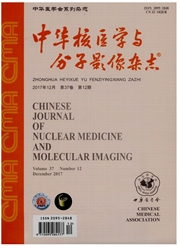

 中文摘要:
中文摘要:
目的构建具有超声和磁场双重响应特性的磁性微泡。方法采用声振空化法制备基于表面活性剂的微泡超声造影剂(ST68),用多元醇法制备表面带负电荷的磁性Fe3O4纳米粒子。以微泡为模板,通过静电吸引层层自组装的方法使聚乙烯亚胺和磁性Fe3O4纳米粒子在微泡表面交替沉积,制备磁性微泡。搭建体外超声造影装置,对比注入磁性微泡(3×10^8个/m1)前后装置中硅胶管的超声图像,并观察对硅胶管施加磁场后磁性微泡的运动情况。对比注入磁性微泡前后新西兰大白兔肾脏的超声图像,以评价磁性微泡的体内超声造影效果。结果制得的Fe3O4纳米粒子表面带有稳定的负电荷(-24.6±6.7)mV,组装得到的磁性微泡中超过98%的微泡粒径小于8μm,满足对超声造影剂大小的基本要求。注人磁性微泡前,硅胶管无回声信号;注入磁性微泡后,硅胶管内呈实性回声;施加磁场后,磁性微泡向磁场方向定向迁移。兔体内超声造影结果示推注磁性微泡前,超声图像不能显示肾;推注后肾脏影清晰。结论制备的磁性微泡磁靶向和超声造影效果良好,为进一步研究具有诊断和治疗双重作用的磁靶向微泡超声造影剂打下了基础。
 英文摘要:
英文摘要:
Objective To manufacture magnetic microbubbles with dualresponse to ultrasound and magnetic fields. Methods Microbubbles of ultrasound contrast agent ( ST68 ) based on a surfactant were prepared by the acoustic cavitation method. Fe3 04 magnetic nanoparticles with negative charge were synthe sized using the polyol procedure. Magnetic microbubbles were generated by depositing polycthylenimine and Fe3O4 magnetic nanoparticles alternately onto the mierobubbles using the layerbylayer selfassembly. In vitro ultrasonography was performed on a silicone tube with/without magnetic mierobubbles (3 x lO^8/ml) by a selfmade device to observe the movement of magnetic microbubbles under the effects of magnetic field. In vivo imaging was performed on the kidney of New Zealand rabbits before and after the injection of magnetic mi crobubbles. Results The Fe304 nanoparticles carried a stable negative charge of ( 24.6 ± 6. 7 ) mV and more than 98% of the particles were less than 8 μm in diameter, meeting the size requirement of an ultra sound contrast agent for intravenous administration. There was no echoic signal in the silicone tube before injection of magnetic microbubbles, but there were strong echoic signals after injection. After applying a magnetic field, the magnetic microbubbles moved along the direction of the magnetic flux. In vivo ultrasound imaging could not visualize the kidney before injection of magnetic microbubblcs, but could remarkably visu alize the kidney after injection. Conclusions The magnetic microbubbles exhibit favorable magnetic targe ting and ultrasound contrast enhancement characteristics. Such properties may serve as the foundation to study their potential for simultaneous diagnosis and treatment in the future.
 同期刊论文项目
同期刊论文项目
 同项目期刊论文
同项目期刊论文
 Bifunctional gold nanorod-loaded polymeric microcapsules for both contrast-enhanced ultrasound imagi
Bifunctional gold nanorod-loaded polymeric microcapsules for both contrast-enhanced ultrasound imagi New Insight into Surface Properties of Self-Assembled Monolayer and Langmuir-Blodgett Film of an Amp
New Insight into Surface Properties of Self-Assembled Monolayer and Langmuir-Blodgett Film of an Amp Fabrication of zonal thiol-functionalized silica nanofibers for removal of heavy metal ions from was
Fabrication of zonal thiol-functionalized silica nanofibers for removal of heavy metal ions from was A novel amperometric biosensor based on single walled carbon nanotubes with acetylcholine esterase f
A novel amperometric biosensor based on single walled carbon nanotubes with acetylcholine esterase f Nanofibrous Lipid Membranes Capable of Functionally Immobilizing Antibodies and Capturing Specific C
Nanofibrous Lipid Membranes Capable of Functionally Immobilizing Antibodies and Capturing Specific C Selective content release from light-responsive microcapsules by tuning the surface plasmon resonanc
Selective content release from light-responsive microcapsules by tuning the surface plasmon resonanc Nanocoating of diazoresin/polysaccharides multilayer boosts biocompatibility of Nitinol biomedical d
Nanocoating of diazoresin/polysaccharides multilayer boosts biocompatibility of Nitinol biomedical d Selective antileukemia effect of stabilized nanohybrid vesicles based on cholesteryl succinyl silane
Selective antileukemia effect of stabilized nanohybrid vesicles based on cholesteryl succinyl silane Glucose biosensor based on covalent immobilization of enzyme in sol-gel composite film combined with
Glucose biosensor based on covalent immobilization of enzyme in sol-gel composite film combined with Gold nanoshelled microcapsules: a theranostic agent for ultrasound contrast imaging and photothermal
Gold nanoshelled microcapsules: a theranostic agent for ultrasound contrast imaging and photothermal Fabrication of gelatin nanofibrous scaffolds using ethanol/phosphate buffer saline as a benign solve
Fabrication of gelatin nanofibrous scaffolds using ethanol/phosphate buffer saline as a benign solve 期刊信息
期刊信息
